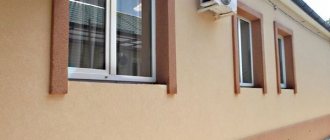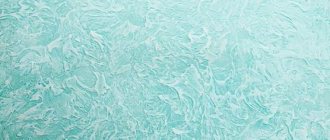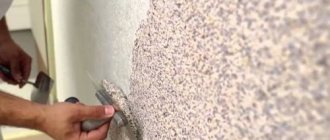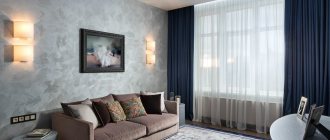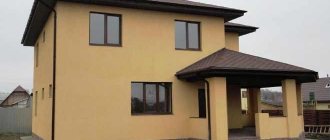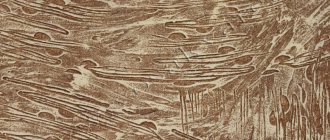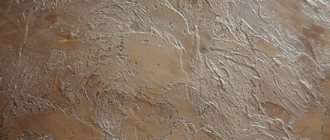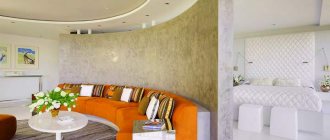Excellent protection against bad weather and climate conditions are the main advantages of “lamb” plaster. In addition to technical advantages, it combines quality with a relatively low price.
The plaster is called “lamb” because of the unusual pattern that results after the material dries on the wall. In a sense, it replaced the material made of sand and cement, called “fur coat” in our area. The material turned out to be better in every way than the old coating, which had many disadvantages.
Modern technologies have made it possible to create a comfortable texture with a distinctive pattern that does not rub off from the surface after drying. The drawing can be made whatever your heart desires: it depends on the experience of the master.
What does it consist of?
Lamb plaster consists of mineral elements that are completely harmless to the environment and humans. If a façade is lined with it, the composition contains components that protect the material from moisture. Without this, the coating could not be durable. This plaster is based on natural ingredients - marble, quartz, etc. Steam does not stagnate on the “lamb”, but, on the contrary, passes through it perfectly.
Everything is balanced in the structure. The composition contains granules up to 1.5 mm, so the finished mass fits well on the surface. Its consumption during application depends on the size of the fillers. The consumption for “lamb” is relatively small, since the thickness of the plaster layer depends on the size of the granules. The granules here are small compared to, for example, “bark beetle” plaster, which is similar in composition and appearance with a fraction of 1.5–3 mm.
Simple mixtures contain sand, which, after drying, settles on the outer layer. The “lamb” crumbs remain in the composition until dry. Usually the semi-finished product has a pale gray color, reminiscent of the skin of the animal of the same name, but the texture can additionally be colored with facade paints or interior paints (when used outside or for interior decoration).
Advice
The mixture can be made from cement, acrylic, silicone or silicate, and is often produced in the form of a ready-made dry mixture.
Description
Plaster "Lamb" refers to textured decorative coatings. It consists of a binder base and mineral grains that form a rough surface. The plaster got its name from its external resemblance to lamb's wool.
Advantages
The main advantages of this facade plaster include:
- ease of application;
- does not accumulate dirt, unlike, for example, the “bark beetle”;
- relatively low cost;
- durability and good performance while following the work technology;
- Possibility of tinting in any colors.
The “lamb” has only one drawback: the simple texture of the plaster may seem boring to some.
You can see what the finishing looks like in the photo below.
Photo
Below you can see photos of decorative plaster:
Application
This type of decorative plaster is more in demand for finishing the exterior walls of a building. Its pebble structure often decorates the facades of multi-story and private houses, office buildings, schools, and hospitals. Plaster mixtures are suitable for “wet facades” using mineral wool and expanded polystyrene.
For interior decoration, “lamb” is also used on landings, in halls, and in places with high traffic. Of course, it is suitable for any walls inside a living space if you decide to add such a texture to your interior.
The basis for plaster can be surfaces from:
- concrete and brick;
- cement and gypsum plaster;
- polystyrene;
- drywall;
- plywood and OSB boards, chipboard;
Next, we’ll look at what mixtures you can choose for plastering and their features.
Preparatory work
The first thing to do is clean the surface to be plastered.
- Paint, old plaster, grease stains - all this needs to be removed, otherwise the material applied on top will begin to peel off.
- Any cracks or defects must be filled with putty.
- If fungus is detected, the surface must be cleaned mechanically, then covered with antiseptic agents. Then treat the wall with a primer - deep-penetrating or adhesive, depending on the type of surface to be applied. It is advisable that the primer and plaster be produced by the same manufacturer.
The coating should be applied to the following walls:
- brick;
- plasterboard;
- cement.
Attention
Before use, it is better to consult with a master finisher.
Watch a detailed video about preparing walls for applying decorative plaster.
Necessary tool
Coating with decorative plaster can be carried out within a temperature range of 5 to 30 degrees Celsius.
You need to prepare the necessary tools for this:
- painting tape or other dense materials to protect from paint those areas that do not need to be painted;
- spatulas - several pieces of different sizes;
- container in which the solution will be mixed;
- sponge or rag to wipe tools;
- paint to cover your type of surface.
You also need gloves to protect your skin.
Algorithm for applying to the wall
You need to spread the mortar onto the wall with a trowel, then you can level it with a spatula and rub it in with a trowel. The mixture is best applied gradually, one square meter at a time. The surface must be leveled within 15 minutes so that it does not dry out by this time, level it with a grater. The layer should be equal to the thickness of the granules - up to 1.5 cm. But the plastered surface should not be too thin: the base should be completely covered with the mixture.
Small granules in the composition will disperse accidentally . After application, the surface will be covered with a pattern depending on the size of the crumb.
When working with the solution, it must be stirred in a container, adding a little water to prevent premature thickening.
To prevent the edges of the plaster from drying out prematurely while working on one area of the wall, it is worth working in pairs. The first one applies the solution, the second levels it or works on the texture.
Important
If the edges dry out prematurely, when all the work is done, the parts will begin to stand out.
Having diluted the mixture, it is best to apply the mixture exactly to the next wall or window opening. Complete drying time is a minimum of 8 hours and a maximum of 2 days. The period depends on the mixture itself and the area of the base to be applied.
You need to paint the “lamb” with a wide brush and roller. A mitten will help soften the colors, and a simple foam sponge can create relief. An aesthetically rich look can be recreated using gold or silver glaze, but don’t go overboard.
The advantage of coloring is that it does not change the texture, and the colors can always be changed. For greater protection, the surface can be coated with wax or varnish.
Check out the instructions for applying lambskin plaster below.
Application technology
There are two ways to apply the material: with a trowel and spraying with a cartouche gun. Let's take a closer look at how the “lamb” texture is made using each of the plastering methods.
Trowel
- I apply the finished or mixed plaster with a spatula from the container onto a metal trowel.
- Holding the tool at an angle to the wall of approximately 45°, apply the mixture in an even layer. Its thickness must be brought to the grain size, i.e. 1.5-2.5 mm. Level the applied layer until no more plaster remains on the trowel.
- It is better to work in squares with an area of 1 - 1.5 m2, because the material sets in 15 - 20 minutes. During this time, it is necessary to level the “lamb” and grout.
- After application, the entire plastered surface must be rubbed with a plastic trowel - a smoothing iron - to highlight the pebble texture. The tool is pressed against the wall with its entire plane and, with slight pressure, is processed in a circular motion.
- Then they move on to decorating the next section of the wall, repeating the entire technology.
Machine application
To apply the “lamb” mechanically, use a cartouche gun connected to a compressor. This is how staircases in the entrance and large facades of buildings are mainly finished.
- The prepared solution is placed in the gun tank.
- Turn on the compressor and spray it evenly onto the wall surface.
- There is no need to rub over the decorative paint with this method of application, because... For machine application, plaster with a fine fraction of crumbs is used, and grouting will smooth out the sprayed texture and become less expressive.
Plaster consumption per 1 m2
Plaster under the “lamb” is placed in one layer with a thickness equal to the grain size. Therefore, the consumption of the decorative mixture will directly depend on this parameter.
- With a granule size of 1.5 mm, the consumption will be 2.5 kg/m2.
- With a value of 2 mm, the consumption will be 3 kg/m2.
Drying time is related to air temperature and the ability of the substrate to absorb moisture. The decor finally hardens after 12 – 24 hours. After a day, the finish becomes resistant to precipitation.
Manufacturers
In order not to make a mistake when choosing, you need to find out about the manufacturers and their products:
- Ceresit is a facade plaster produced by the German concern Henkel. It is well known in Russia and occupies a leading position in the finishing materials market. The brand has a wide range of materials for decorative plastering.
- Bolars is a material originally from Russia, based on German equipment. In 1999, production of this brand was launched. The products have repeatedly received quality marks. Today it is a recognizable and sought-after brand.
- Knauf is one of the most famous brands in the construction market. Has many options in choosing the basis for the facade. The company began its development back in 1932, because this manufacturer has extensive experience and knowledge, thanks to which at the current time the quality of their products is not in doubt.
- Bolix is a Polish-made decorative plaster that is also famous in Russia. The assortment includes a large selection of different colors and volumes.
Caparol, made in Germany, is known in Europe. A high-quality mixture with excellent protection properties.
- TIM 26 has good frost resistance, facade plaster has many other advantages: protection from water, elasticity, durability. The mixture can be used to cover buildings in frosty areas of Europe. Produced in Russia.
- Prospectors - produced by a popular company in the Russian Federation of the same name, which has been selling products since 1992. Goods of good quality and affordable price.
- Volma is a very durable cement mixture. Produced at the Volgograd gypsum plant. Volma is the leader in Russia in terms of production volumes.
- Kreisel is distinguished by good quality, relatively affordable price, as well as a pleasant, easy application of plaster. A mixture of German production.
- Bergauf is a versatility and a wide range of properties such as protection from cold, plasticity, protection from water, and thermal insulation. A large range of products allows you to choose a mixture for almost any situation. Produced in the Sverdlovsk region.
- Perfekta – designed for covering facades, plinths and industrial premises. It is resistant to weather conditions and physical damage.
- OSNOVIT is a product of a modern Russian manufacturer. The company is one of the leaders in the construction market. The base of this material allows steam to pass through itself and is resistant to damage and weather conditions.
Advice
If you want to buy Lamb plaster, we advise you to first decide on the design, and then make your choice in favor of a specific material.
Advantages of decorative plaster Lamb
The material is available in a wide variety of colors. Thanks to this, additional painting is not necessary.
Among other advantages of the material are:
- resistance to frost and water;
- simple method of application;
- additional strengthening of walls;
- preventing condensation formation;
- resistance to mechanical damage;
- ability to withstand heavy loads.
Lamb is a fireproof building material. Plaster goes well with various types of design, and is able to withstand aggressive atmospheric environments and low temperatures.
At the moment, there are thousands of options for decorative plaster; the material allows you to solve the problem of finishing the facade once and for all. Decorative plaster serves to protect the house from ultraviolet rays, temperature changes and even mechanical influences.
Facade plaster “Lamb” gives the surface a beautiful textured look.
Before you start finishing the facade of the house, you need to familiarize yourself with the material options:
Acrylic plaster "Lamb".
Acrylic decorative plaster is designed to create a thin decorative layer with a granular structure on mineral bases. Acrylic plasters contain an aqueous dispersion based on acrylic copolymers.
Siloxane plaster “Lamb”.
Silicone plaster is an intermediate product between acrylic and silicone plaster. Its technical properties are slightly better than acrylic plaster, but still do not reach silicone plaster. Thanks to acrylic copolymers and silicone additives in the composition, the plaster has high vapor permeability and is resistant to ultraviolet rays.
Silicone plaster "Lamb".
Ideal value for money. The service life of the material is up to 25 years. Due to the silicone additives in the composition, the material is quite elastic, this property helps to protect the walls as much as possible from cracks, even when the house shrinks.
Due to its vapor-permeable properties, decorative plaster “Lamb” is considered an ideal option for finishing walls made of foam or aerated concrete, ensuring a normal indoor microclimate.
Next comes the preparation of the surface for plastering; you can read how to properly prepare the surface for plastering in our article “Preparing the base for plastering.”
Advice: even if you think that the base looks strong and is ready for plastering, you should not skimp on the primer; be sure to prime the surface before applying the plaster.
Decorative plaster “Lamb” is applied using a spatula, trowel and grater. It is necessary to work without stopping from corner to corner so that there are no joints between sections.
After applying the plaster, it is necessary to remove all excess. The excess is considered completely removed when it does not remain on the trowel.
Reviews
- Oleg. We were advised to do lamb plaster purely for technical reasons. The fact is that the wall in the house often cracks, and on a flat surface this is very noticeable. After the relief plaster was applied, the problems decreased:
- Firstly, small cracks and scratches are completely invisible.
Secondly, after a while you can just touch it up a little and nothing will be noticeable at all.
- Igor .
I am pleased with the lamb plaster that it is very resistant to all kinds of damage. We have two children in our house and a ball or something else is constantly flying into the wall. No special scuffs or scratches should be noticeable. An excellent option for those who want to save a lot of money and at the same time get a beautiful and smooth facade. Plus a wide selection of colors. If you need soft yellow or bright orange, you can choose the appropriate option to suit your requirements and wishes. - Marina . I ordered Lamb plaster considering its affordable price and technical performance. Ideally helped to hide all the unevenness on our walls. I thought that it would be much more dirty than usual, but in the end it turned out to be the opposite. The material looks quite beautiful and is very economical. A good option for every family. I recommend.
Plus, of course, I consider the low price and relative ease of application to be an advantage. Even if the master is not a top-level professional, it will still turn out very well. But if you apply even putty, then a jack of all trades really needs to get down to business.
Decorative textured plaster lamb: what is its feature
“Lamb” plaster gained its popularity back in the USSR. True, it had a completely different name back then and many remember it as the grainy finish “Shuba”.
This material is used for finishing work indoors, as well as for decorating the facade. Thanks to the grainy texture, a very unusual design is obtained. This composition can be used on any surface: cement, gypsum or ordinary lime plaster.
The heterogeneous composition makes it possible to decorate the walls to your taste: for example, in a watercolor style or create an imitation of a wooden surface. That is why “Lamb” plaster is used in the design of cafes, houses, hotels, holiday homes and apartments.
In addition, the material allows you to disguise flaws on the walls: cracks, potholes. And the surface coated with such a composition becomes more resistant to moisture, sun, and mechanical damage.
The appearance of this coating looks like new for a long time and does not require special care. You can simply carry out wet cleaning with a rag.
